Heinkel He 162
The Heinkel He 162 Volksjäger (German, "People's Fighter"), the name of a project of the Emergency Fighter Program design competition, was a German single-engine, jet-powered fighter aircraft fielded by the Luftwaffe in World War II. It was designed and built quickly and made primarily of wood as metals were in very short supply and prioritised for other aircraft. Volksjäger was the Reich Air Ministry's official name for the government design program competition won by the He 162 design. Other names given to the plane include Salamander, which was the codename of its construction program, and Spatz ("Sparrow"), which was the name given to the plane by Heinkel.
| He 162 | |
|---|---|
.jpg) | |
| He 162 120230 during post-war trials, USA. | |
| Role | Jet fighter |
| Manufacturer | Heinkel |
| Designer | Heinkel |
| First flight | 6 December 1944 |
| Introduction | January 1945 |
| Retired | May 1945 |
| Status | Retired |
| Primary user | Luftwaffe |
| Number built | ca 320 |
Development
State of the Luftwaffe fighter arm
Through 1943 the U.S. 8th Air Force and German Luftwaffe entered a period of rapid evolution as both forces attempted to gain an advantage. Having lost too many fighters to the bombers' defensive guns, the Germans invested in a series of heavy weapons that allowed them to attack from outside the American guns' effective range. The addition of heavy cannons like the 30mm calibre MK 108, and even heavier Bordkanone autoloading weapons in 37mm and 50mm calibres on their Zerstörer heavy fighters, and the spring-1943 adoption of the Werfer-Granate 21 unguided rockets, gave the German single and twin-engined defensive fighters a degree of firepower never seen previously by Allied fliers. Meanwhile, the single-engine aircraft like specially equipped Fw 190As added armor to protect their pilots from Allied bombers' defensive fire, allowing them to approach to distances where their heavy weapons could be used with some chance of hitting the bombers. All of this added greatly to the weight being carried by both the single and twin-engine fighters, seriously affecting their performance.
When the 8th Air Force re-opened its bombing campaign in early 1944 with the Big Week offensive, the bombers returned to the skies with the long-range P-51 Mustang in escort. Unencumbered with the heavy weapons needed to down a bomber, the Mustangs (and longer-ranged versions of other aircraft) were able to fend off the Luftwaffe with relative ease. The Luftwaffe responded by changing tactics, forming in front of the bombers and making a single pass through the formations, giving the defense little time to react. The 8th Air Force responded with a change of its own, after Major General Jimmy Doolittle had ordered a change in fighter tactics earlier in 1944, amounting to an air supremacy entry into German airspace far ahead of the bombers' combat box formations – when at the end of April, Doolittle added additional directives allowing the fighters, following the bombers' flight back home to England, to roam freely over Germany and hit the Luftwaffe's defensive fighters wherever they could be found.
This change in tactics resulted in a sudden increase in the rate of irreplaceable losses to the Luftwaffe day fighter force, as their heavily laden aircraft were "bounced" long before reaching the bombers. Within weeks, many of their aces were dead, along with hundreds of other pilots, and the training program could not replace their casualties quickly enough. The Luftwaffe put up little fight during the summer of 1944, allowing the Allied landings in France to go almost unopposed from the air. With few planes coming up to fight, Allied fighters were let loose on the German airbases, railways and truck traffic. Logistics soon became a serious problem for the Luftwaffe, as maintaining aircraft in fighting condition became almost impossible. Getting enough fuel was even more difficult because of a devastating campaign against German petroleum industry targets.
Origins
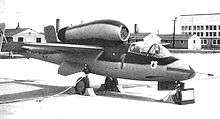
Addressing this posed a considerable problem for the Luftwaffe. Two camps quickly developed, both demanding the immediate introduction of large numbers of jet fighter aircraft. One group, led by General Adolf Galland, the Inspector of Fighters, reasoned that superior numbers had to be countered with superior technology, and demanded that all possible effort be put into increasing the production of the Messerschmitt Me 262 in its A-1a fighter version, even if that meant reducing production of other aircraft in the meantime.
The second group pointed out that this would likely do little to address the problem; the Me 262 had notoriously unreliable powerplants and landing gear, and the existing logistics problems would mean there would merely be more of them on the ground waiting for parts that would never arrive, or for fuel that was not available. Instead, they suggested that a new design be built – one so inexpensive that if a machine was damaged or worn out, it could simply be discarded and replaced with a fresh plane straight off the assembly line. Thus was born the concept of the "throwaway fighter".
Galland and other Luftwaffe senior officers expressed vehement opposition to the light fighter idea, while Reichsmarschall Hermann Göring and Armaments Minister Albert Speer fully supported the idea. Göring and Speer got their way, and a contract tender for a single-engine jet fighter that was suited for cheap and rapid mass production was established under the name Volksjäger ("People's Fighter").
Volksjäger
The official RLM Volksjäger design competition parameters specified a single-seat fighter, powered by a single BMW 003,[1] a slightly lower-thrust engine not in demand for either the Me 262 or the Ar 234, already in service. The main structure of the Volksjäger competing airframe designs would use cheap and unsophisticated parts made of wood and other non-strategic materials and, more importantly, could be assembled by semi- and non-skilled labor, including slave labor.[2] Specifications included a weight of no more than 2,000 kg (4,400 lb),[3] with maximum speed specified as 750 km/h (470 mph) at sea level, operational endurance at least a half hour, and the takeoff run no more than 500 m (1,640 ft). Armament was specified as either two 20 mm (0.79 in) MG 151/20 cannons with 100 rounds each, or two 30 mm (1.2 in) MK 108 cannons with 50 rounds each. The Volksjäger needed to be easy to fly. Some suggested even glider or student pilots should be able to fly the jet effectively in combat, and indeed had the Volksjäger gone into full production, that is precisely what would have happened. After the war, Ernst Heinkel would say, "[The] unrealistic notion that this plane should be a 'people's fighter,' in which the Hitler Youth, after a short training regimen with clipped-wing two-seater gliders like the DFS Stummel-Habicht, could fly for the defense of Germany, displayed the unbalanced fanaticism of those days."[4] The clipped-wingspan DFS Habicht models had varying wingspans of both 8 m (26 ft 3 in) or 6 m (19 ft 8 in), and were used to prepare more experienced Luftwaffe pilots for the dangerous Me 163B Komet rocket fighter – the same sort of training approach would also be used for the Hitler Youth aviators chosen to fly the jet-powered Volksjäger design competition's winning airframe design.
The requirement was issued 10 September 1944, with basic designs to be returned within 10 days and to start large-scale production by 1 January 1945. Because the winner of the new lightweight fighter design competition would be building huge numbers of the planes, nearly every German aircraft manufacturer expressed interest in the project, such as Blohm & Voss, and Focke-Wulf, whose Focke-Wulf Volksjäger 1 design contender, likewise meant for BMW 003 turbojet power bore a resemblance to their slightly later Ta 183 Huckebein jet fighter design. However, Heinkel had already been working on a series of "paper projects" for light single-engine fighters over the last year under the designation P.1073, with most design work being completed by Professor Benz, and had gone so far as to build and test several models and conduct some wind tunnel testing.[5]
Although some of the competing designs were technically superior (in particular to the Blohm & Voss P 211 submission[6]), with Heinkel's head start the outcome was largely a foregone conclusion. The results of the competition were announced in October 1944, only three weeks after being announced, and to no one's surprise, the Heinkel entry was selected for production. In order to confuse Allied intelligence, the RLM chose to reuse the 8-162 airframe designation (formerly that of a Messerschmitt fast bomber) rather than the other considered designation He 500.
Design
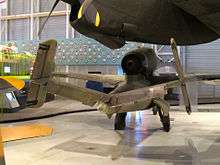
Heinkel had designed a relatively small, 'sporty'-looking aircraft, with a sleek, streamlined fuselage. Overall, the look of the plane was extremely modernistic for its time, appearing quite contemporary in terms of layout and angular arrangement even to today's eyes. The BMW 003 axial-flow turbojet was mounted in a pod nacelle uniquely situated atop the fuselage,[7] just aft of the cockpit and centered directly over the wing's center section. Twin roughly rectangular vertical tailfins were perpendicularly mounted at the ends of highly dihedralled horizontal tailplanes – possessing dihedral of some 14º apiece[8] – to clear the jet exhaust, a high-mounted straight wing (attached to the fuselage with just four bolts)[3] with a forward-swept trailing edge and a noticeably marked degree of dihedral, with an ejection seat provided for the pilot – which the Heinkel firm had pioneered in a front-line combat aircraft, with the earlier He 219 night fighter in 1942. The He 162 airframe design featured an uncomplicated tricycle landing gear, the first such landing gear system to be present from the very start in any operational Axis Powers single-engined fighter design, that retracted into the fuselage, performed simply with extension springs, mechanical locks, cables and counterweights, and a minimum of any hydraulics employed in its design – a window in the lower forward cockpit area, between the rudder pedals, allowed for visual checking of the nosegear's retraction operation.[9][10][11] Partly due to the late-war period it was designed within, some of the He 162's landing gear components were "recycled" existing landing gear components from a contemporary German military aircraft to save development time: the main landing gear's oleo struts and wheel/brake units came from the Messerschmitt Bf 109K, as well as the double-acting hydraulic cylinders, one per side, used to raise and lower each maingear leg.[12] The Heinkel firm's previous experience with designing flightworthy, retractable tricycle undercarriage-equipped airframes extended as far back as late 1939[13] with the Heinkel He 280 jet fighter prototype, and further strengthened with the unexpectedly successful Heinkel He 219A night fighter, which also used a tricycle undercarriage.
The He 162 V1 first prototype flew within an astoundingly short period of time: the design was chosen on 25 September 1944 and first flew on 6 December,[7] less than 90 days later. This was despite the fact that the factory in Wuppertal making Tego film plywood glue — used in a substantial number of late-war German aviation designs whose airframes and/or major airframe components were meant to be constructed mostly from wood — had been bombed by the Royal Air Force and a replacement had to be quickly substituted, without realizing that the replacement adhesive was highly acidic and would disintegrate the wooden parts it was intended to be fastening.
The first flight of the He 162 V1, by Flugkapitän Gotthold Peter – the first German jet fighter aircraft design to be jet-powered from its maiden flight onward – was fairly successful, but during a high-speed run at 840 km/h (520 mph), the highly acidic replacement glue attaching the nose gear strut door failed and the pilot was forced to land. Other problems were noted as well, notably a pitch instability and problems with sideslip due to the rudder design.[3] None were considered important enough to hold up the production schedule for even a day. On a second flight on 10 December, again with Peter at the controls, in front of various Nazi officials, the glue again caused a structural failure. This allowed the aileron to separate from the wing, causing the plane to roll over and crash, killing Peter.[7]
An investigation into the failure revealed that the wing structure had to be strengthened and some redesign was needed, as the glue bonding required for the wood parts was in many cases defective.[7] However, the schedule was so tight that testing was forced to continue with the current design. Speeds were limited to 500 km/h (310 mph) when the second prototype flew on 22 December. This time, the stability problems proved to be more serious, and were found to be related to Dutch roll, which could be solved by reducing the dihedral. However, with the plane supposed to enter production within weeks, there was no time to change the design. A number of small changes were made instead, including adding lead ballast to the nose to move the centre of gravity more to the front of the plane, and slightly increasing the size of the tail surfaces.
The third and fourth prototypes, which now used an "M" for "Muster" (model) number instead of "V" for "Versuchs" (experimental) number, as the He 162 M3 and M4, after being fitted with the strengthened wings, flew in mid-January 1945. These versions also included – as possibly the pioneering example of their use on a production-line, military jet aircraft – small, anhedraled aluminium "drooped" wingtips, reportedly designed by Alexander Lippisch and known in German as Lippisch-Ohren ("Lippisch Ears"), in an attempt to cure the stability problems via effectively "decreasing" the main wing panels' marked three degree dihedral angle.[14] Both prototypes were equipped with two 30 mm (1.18 in) MK 108 cannons in the He 162 A-1 anti-bomber variant; in testing, the recoil from these guns proved to be too much for the lightweight fuselage to handle, and plans for production turned to the A-2 fighter with two 20 mm MG 151/20 cannons instead while a redesign for added strength started as the A-3. The shift to 20 mm guns was also undertaken because the smaller-calibre weapons would allow a much greater amount of ammunition to be carried.
The He 162 was originally built with the intention of being flown by the Hitler Youth, as the Luftwaffe was fast running out of pilots. However, the aircraft's complexity required more experienced pilots. Both a standard-fuselage length, unarmed BMW 003E-powered two-seat version (with the rear pilot's seat planned to have a ventral access hatch to access the cockpit) and an unpowered two-seat glider version, designated the He 162S (Schulen), were developed for training purposes. Only a small number were built, and even fewer delivered to the sole He 162 Hitler Youth training unit to be activated (in March 1945) at an airbase at Sagan. The unit was in the process of formation when the war ended, and did not begin any training; it is doubtful that more than one or two He 162S gliders ever took to the air.
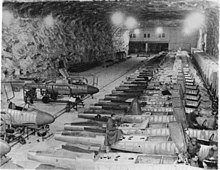
Various changes had raised the weight over the original 2,000 kg (4,410 lb) limit, but even at 2,800 kg (6,170 lb), the aircraft was still among the fastest aircraft in the air with a maximum airspeed of 790 km/h (427 kn; 491 mph) at sea level and 839 km/h (453 kn; 521 mph) at 6,000 m (20,000 ft),[15] but could reach 890 km/h (481 kn; 553 mph) at sea level and 905 km/h (489 kn; 562 mph) at 6,000 m (20,000 ft) using short burst extra thrust.[16] The short flight duration of barely 30 minutes was due to only having a single 695-litre (183 US gallon) capacity flexible-bladder fuel tank in the fuselage directly under the engine's intake.[17] The original Baubeschreibung document submittal for the He 162 dated mid-October 1944 showed a pair of fuel tanks for the original version of the Spatz's airframe as-designed: a single, smaller capacity 640 litre (169 US gal) fuselage main tank in approximately the same location as the later 695 litre tank was placed, with an additional wing centre-section tank just above and behind it, never produced for the production run, of some 325 litres (86 US gal) feeding by gravity into the main fuselage tank.[18] The A-2 version, in some examples (as the one flown by RN Captain Eric Brown postwar) had an emplacement of a pair of "impregnated" 180 litre (47.5 US gal) wing tanks, one built into each inner wing panel, within the first four wing ribs out from the root and between the spars, that fed into the main 695 litre fuselage tank in a similar manner to what the earlier 325 litre center-section tank had been proposed to do; but were themselves ungauged, their exhaustion of fuel only marked when the main fuel gauge began to fall during flight.[19] The production He 162A-2 was armed with a pair of 20mm MG 151/20 cannon.[15]
He 162 construction facilities were at Salzburg, the Hinterbrühl, and the Mittelwerk.[20] Output was expected to be 1,000 a month by April 1945, double that when the Mittlewerk plant began deliveries.[15]
Operations
In January 1945, the Luftwaffe formed an Erprobungskommando 162 ("Test Unit 162") evaluation group to which the first 46 aircraft were delivered. The group was based at the Luftwaffe main test center, or Erprobungsstelle at Rechlin.
February saw deliveries of the He 162 to its first operational unit, I./JG 1 (1st Group of Jagdgeschwader 1 Oesau — "1st Fighter Wing"), which had previously flown the Focke-Wulf Fw 190A. I./JG 1 was transferred to Parchim, which, at the time, was also a base for the Me 262-equipped Jagdgeschwader 7, some 80 km south-southwest of the Heinkel factory's coastal airfield at "Marienehe" (today known as Rostock-Schmarl, northwest of the Rostock city centre), where the pilots could pick up their new jets and start intensive training beginning in March 1945. This was all happening simultaneously with unrelenting Allied air attacks on the transportation network, aircraft production facilities and petroleum, oil, and lubrication (POL) product-making installations of the Third Reich – these had now begun to also target the Luftwaffe's jet and rocket fighter bases as well. On 7 April, the USAAF bombed the field at Parchim with 134 B-17 Flying Fortresses, inflicting serious losses and damage to the infrastructure. Two days later, I./JG 1 moved to an airfield at nearby Ludwigslust and, less than a week later, moved again to an airfield at Leck, near the Danish border. On 8 April, II./JG 1 moved to Heinkel's aforementioned Rostock northwestern coastal suburban factory airfield and started converting from Fw 190As to He 162s. III./JG 1 was also scheduled to convert to the He 162, but the Gruppe disbanded on 24 April and its personnel were used to fill in the vacancies in other units.
The He 162 first saw combat in mid-April 1945. On 19 April, Feldwebel Günther Kirchner shot down a Royal Air Force fighter, and although the victory was credited to a flak unit, the British pilot confirmed during interrogation that he had been downed by an He 162.[21] The Heinkel and its pilot were lost as well, shot down by an RAF Hawker Tempest while on approach to land, a point at which Allied pilots targeted German jets. Though still in training, I./JG 1 had begun to score kills in mid-April, but had also lost 13 He 162s and 10 pilots. Ten of the aircraft were operational losses, caused by flameouts and sporadic structural failures. Only two of the 13 aircraft were actually shot down. The He 162's 30-minute fuel capacity also caused problems, as at least two of JG 1's pilots were killed attempting emergency deadstick landings after exhausting their fuel.
During its exceedingly brief operational service career, the 162's cartridge-type ejector seat was employed under combat conditions by JG 1's pilots at least three times. The first recorded use was by Lt Rudolf Schmidt on April 20, with Fw. Erwin Steeb ejecting from his 162 the following day. Finally, Hptm. Paul-Heinrich Dahne attempted an ejection on April 24, but was killed when the aircraft's cockpit canopy failed to detach.
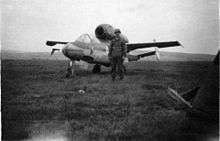
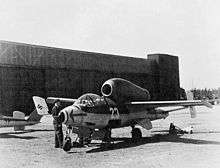
In the last days of April, as the Soviet troops approached, II./JG 1 evacuated from Marienehe and on 2 May joined the I./JG 1 at Leck. On 3 May, all of JG 1's surviving He 162s were restructured into two groups, I. Einsatz ("Combat") and II. Sammel ("Collection"). All JG 1's aircraft were grounded on 5 May, when General Admiral Hans-Georg von Friedeburg signed the surrender of all German armed forces in the Netherlands, Northwest Germany and Denmark. On 6 May, when the British reached their airfields, JG 1 turned their He 162s over to the Allies, and examples were shipped to the U.S., Britain, France, and the Soviet Union for further evaluation. Erprobungskommando 162 fighters, which had been passed on to JV 44, an elite jet unit under Adolf Galland a few weeks earlier, were all destroyed by their crews to keep them from falling into Allied hands. By the time of the German unconditional surrender on 8 May 1945, 120 He 162s had been delivered; a further 200 had been completed and were awaiting collection or flight-testing; and about 600 more were in various stages of production.
The difficulties experienced by the He 162 were caused mainly by its rush into production, not by any inherent design flaws.[22] One experienced Luftwaffe pilot who flew it called it a "first-class combat aircraft." Eric "Winkle" Brown of the Fleet Air Arm, who flew a record 486 different types of aircraft, said the He 162 had "the lightest and most effective aerodynamically balanced controls" he had experienced.[23] Brown had been warned to treat the rudder with suspicion due to a number of in-flight failures. This warning was passed on by Brown to RAF pilot Flt Lt R A Marks, but was apparently not heeded. On 9 November 1945, during a demonstration flight from RAE Farnborough, one of the fin and rudder assemblies broke off at the start of a low-level roll causing the aircraft to crash into Oudenarde Barracks, Aldershot, killing Marks and a soldier on the ground.[24]
He 162 Mistel
The Mistel series of fighter/powered bomb composite ground-attack aircraft pre-dated the He 162 by over two years, and the Mistel 5 project study in early 1945 proposed the mating of an He 162A-2 to the Arado E.377A flying bomb. The fighter would sit atop the bomb, which would itself be equipped with two underwing-mounted BMW 003 turbojets. This ungainly combination would take off on a sprung trolley fitted with tandem wheels on each side for the "main gear" equivalent, derived from that used on the first eight Arado Ar 234 prototypes, with all three jets running. Immediately after take-off, the trolley would be jettisoned, and the Mistel would then fly to within strike range of the designated target. Upon reaching this point, the bomb would be aimed squarely at the target and then released, with the jet turning back for home. The Mistel 5 remained a "paper project", as the Arado bomb never progressed beyond the blueprint stage.
Variants
- He 162 A-0 — first ten pre-production aircraft.
- He 162 A-1 — armed with two 30 mm (1.18 in) MK 108 cannons with 50 rounds per gun.
- He 162 A-2 — armed with two 20 mm MG 151/20 cannons with 120 rounds per gun.
- He 162 A-3 — proposed upgrade with reinforced nose mounting twin 30 mm MK 108 cannons.
- He 162 A-8 — proposed upgrade with the more powerful Jumo 004D-4 engine of 10.3 kN (2,300 lbf) top thrust levels. Muster (model) prototype airframes M11 and M12's testing revealed a top speed of 885 km/h (550 mph) at sea level at normal thrust and 960 km/h (597 mph) with maximum thrust,[25] close to the Me 163B rocket fighter's top velocity figures.
- He 162 B-1 — a proposed follow on planned for 1946, meant to use the Heinkel firm's own, more powerful 12 kN (2,700 lb) thrust Heinkel HeS 011A turbojet, a stretched fuselage to provide more fuel and endurance as well as increased wingspan, with reduced dihedral which allowed the omission of the anhedral wingtip devices. To be armed with twin 30 mm (1.18 in) MK 108s.
- The He 162B airframe was also used as the basis for the Miniature Fighter Project design competition powered by one or two "square-intake" Argus As 044 pulsejet engines. The pulsejet, however didn't provide enough thrust for takeoff and neither Heinkel nor the OKL showed much enthusiasm for the project.[26]
- He 162C — proposed upgrade featuring the B-series fuselage, Heinkel HeS 011A engine, swept-back, anhedraled outer wing panels forming a gull wing, a new V-tail stabilizing surface assembly, and upward-aimed twin 30 mm (1.18 in) MK 108s as a Schräge Musik weapons fitment, located right behind the cockpit.
- He 162D — proposed upgrade with a configuration similar to C-series but a dihedraled forward-swept wing.
- He 162E — He 162A fitted with the BMW 003R mixed power plant, a BMW 003A turbojet with an integrated BMW 718 liquid-fuel rocket engine — mounted just above the exhaust orifice of the turbojet — for boost power. At least one prototype was built and flight-tested for a short time.
- He 162S — two-seat training glider.
Aircraft on display
![]()
- An He 162 A-2 (Werknummer 120227) of JG 1 is on display at the Royal Air Force Museum London, Hendon, London, UK.
- An He 162 A-2 (Werknummer 120077) is displayed at the Planes of Fame Museum on static display in Chino, California, USA. This aircraft was captured by the British at Leck and sent to the United States in 1945 where it was given the designation FE-489 (Foreign Equipment 489) and later T-2-489.[27]
- An He 162 A-2 (Werknummer 120230), thought to have been flown by Oberst Herbert Ihlefeld of 1./JG 1, is currently owned by the American Smithsonian Institution's National Air and Space Museum, USA. This He 162A, after being captured by the British at Leck and sent to the US on board HMS Reaper escort carrier, is currently fitted with the tail unit from Werknummer 120222
- Two He 162 A-2s (Werknummer 120086 and 120076) were owned by Canada Aviation and Space Museum, 120086 is assembled, and as of January 2012 on display. Werknummer 120076 was traded to Aero Vintage in the UK for a Bristol Fighter (G-AANM, D-7889) in December 2006. Investigations are currently being made into the practicality of an airworthy restoration of Werknummer 120076. Aircraft in Profile 203 reported that both aircraft as having been refurbished in Canada in the 1960s.[28] Currently Werknummer 120076 is displayed in Deutsches Technikmuseum Berlin.[29]
- An He 162 A-1 (Werknummer 120235) is in Hangar 5 of The Imperial War Museum Duxford, UK.
- An He 162 A-2 (Werknummer 120015) formerly of III./JG1, is currently under restoration at the Musée de l'Air et de l'Espace near Paris, France, with a fully restored and operable retracting landing gear.[9]
- An He 162 is most likely in storage at the US Smithsonian's National Air and Space Museum (Werk Nummer 120222, Air Force number T-2-504).[27]
- Wk. Nr. 120227, RAF Museum, London
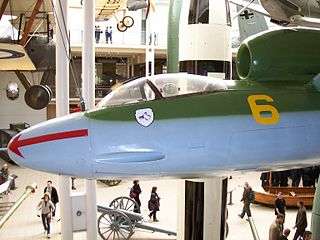 Wk. Nr. 120235, Imperial War Museum, London (now moved to Duxford)
Wk. Nr. 120235, Imperial War Museum, London (now moved to Duxford)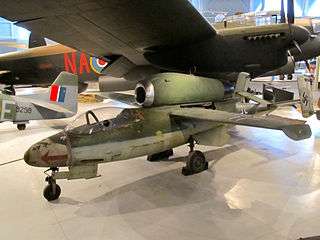 Wk. Nr. 120086, Canada Aviation and Space Museum, Ottawa
Wk. Nr. 120086, Canada Aviation and Space Museum, Ottawa
Reproduction
- He 162, produced by George Lucas (Nunday NY) displayed at National Warplane Museum, Geneseo NY (www.nationalwarplanemuseum.com)
Specifications (He 162A)
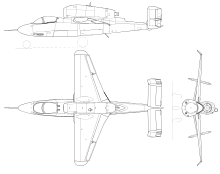
Data from Hitler's Luftwaffe[17]
General characteristics
- Crew: 1
- Length: 9.05 m (29 ft 8 in)
- Wingspan: 7.2 m (23 ft 7 in)
- Height: 2.6 m (8 ft 6 in)
- Wing area: 11.16 m2 (120.1 sq ft)
- Empty weight: 1,660 kg (3,660 lb)
- Max takeoff weight: 2,800 kg (6,173 lb)
- Fuel capacity: 695 l (184 US gal; 153 imp gal)
- Powerplant: 1 × BMW 109-003E-1 or BMW 109-003E-2 turbojet engine
Performance
- 840 km/h (520 mph; 450 kn) at 6,000 m (20,000 ft) (normal thrust)
- 890 km/h (550 mph; 480 kn) at sea level (emergency boosted thrust)
- 905 km/h (562 mph; 489 kn) at 6,000 m (20,000 ft) (emergency boosted thrust)
- Range: 975 km (606 mi, 526 nmi)
- Service ceiling: 12,000 m (39,000 ft)
- Rate of climb: 23.42 m/s (4,610 ft/min)
- Thrust/weight: 0.35 (normal thrust)
- 0.41 (emergency boosted thrust)
Armament
- Guns: 2 × 20 mm (0.787 in) MG 151/20 autocannon with 120 rpg (He 162 A-2) OR 2 × 30 mm (1.181 in) MK 108 cannon with 50 rpg (He 162 A-0, A-1)
See also
Aircraft of comparable role, configuration and era
Related lists
References
Notes
- Christopher, John. The Race for Hitler's X-Planes (The Mill, Gloucestershire: History Press, 2013), p.145.
- Christopher, p.145. Christopher also records "unskilled labor" as a euphemism.
- Christopher, p.145.
- Excerpt from Lucas Arts' "Secret Weapons of Luftwaffe" CD-ROM's Text Manual
- Heinkel He P.1073 (variants)
- Blohm & Voss P.211/02
- Ford, Roger (2013). Germany's Secret Weapons of World War II. London, United Kingdom: Amber Books. p. 224. ISBN 9781909160569.
- "Baubeschreibung des einmotorigen Jagdeinsitzers, Baumuster 162, mit TL-Triebwerk BMW 003 E-1 (in German)" (PDF). deutsche-luftwaffe.de. Heinkel Flugzeugwerke. 15 October 1944. p. 40. Archived from the original (PDF) on 4 August 2016. Retrieved July 6, 2016.
- Heinkel 162 (He162) landing gear test (YouTube) (YouTube). Le Bourget, Paris, France: memorialflight. 2008. Retrieved July 9, 2013.
- Animation of He 162 nosegear retraction cycle
- Animation of He 162 maingear retraction cycle
- Sengfelder, Günther (1993). German Aircraft Landing Gear. Atglen, PA USA: Schiffer Publishing. pp. 136–137. ISBN 0-88740-470-7.
The He 162's landing gear consisted partly of elements taken from other designs. The main landing gear legs and wheels were from the Bf 109K. The hydraulic jack used to raise and lower the landing gear was also taken from the Bf 109.
- Christopher, John (2013). The Race for Hitler's X-Planes: Britain's 1945 Mission to Capture Secret Luftwaffe Technology. The Mill, Gloucestershire UK: History Press. p. 58.
- "Baubeschreibung des einmotorigen Jagdeinsitzers, Baumuster 162, mit TL-Triebwerk BMW 003 E-1 (in German)" (PDF). deutsche-luftwaffe.de. Heinkel Flugzeugwerke. 15 October 1944. p. 39. Archived from the original (PDF) on 4 August 2016. Retrieved July 6, 2016.
- Christopher, p.146.
- Donald 1994, p.119.
- Wood, Tony; Gunston, Bill. Hitler's Luftwaffe. London: Salamander Books. pp. 194–195. ISBN 0-517-22477-1.
- "Baubeschreibung des einmotorigen Jagdeinsitzers, Baumuster 162, mit TL-Triebwerk BMW 003 E-1 (in German)" (PDF). deutsche-luftwaffe.de. Heinkel Flugzeugwerke. 15 October 1944. p. 43. Archived from the original (PDF) on 4 August 2016. Retrieved July 6, 2016.
- Brown, Eric (1977). Wings of the Luftwaffe. Pilot Press Ltd. pp. 24–25. ISBN 0-385-13521-1.
On the climb the fuel gauge began to drop, indicating that the two ungauged wing tanks had completely drained their contents into the main tank.
- Christopher, p.146, says Marienehe (today's Rostock-Schmarl northwestern coastal neighborhood), a chalk mine at Mödling, and Mittelwerk.
- Mombeek 1992, p. 297.
- Lepage 2009, p. 266.
- Brown, Eric. "Mastering Heinkel's Minimus; Air Enthusiast, 2:6, June 1972
- "Two Killed In Flying Accident." Times [London, England] 10 Nov. 1945: 2. The Times Digital Archive. 4 May 2013.
- The Heinkel He-162 Volksjaeger
- Maloney 1965
- Smith & Conway 1972, p. 12.
- Deutsches Technikmuseum Berlin - Medieninfo: Heinkel He 162
Bibliography
- Brown, Capt. Eric (CBE, DSC, AFC, RN). "Heinkel He 162" Wings of the Luftwaffe. Garden City, NY: Doubleday & Company, INc., 1978. ISBN 0-385-13521-1.
- Donald, David. "Warplanes of the Luftwaffe". Aerospace Publishing London. 1994. ISBN 1-874023-56-5.
- Forsyth, Robert. "Heinkel He162 Volksjager" Classic Publications, 21 May 2009. ISBN 1906537003.
- Lepage, Jean-denis G. G. Aircraft of the Luftwaffe 1935–1945: An Illustrated History. Jefferson, NC: McFarland, 2009. ISBN 978-0-7864-3937-9.
- Maloney, Edward T. and the Staff of Aero Publishers, Inc. Heinkel He 162 Volksjager (Aero Series 4). Fallbrook, CA: Aero Publishers, Inc., 1965. ISBN 0-8168-0512-1.
- Mombeek, Eric. "Defending the Reich- The History of Jagdgeschwader 1 'Oesau'". Norfolk, UK: JAC Publications, 1992. ISBN 0-9515737-1-3.
- Smith, J. Richard and Conway, William. The Heinkel He 162 (Aircraft in Profile number 203). Leatherhead, Surrey, UK: Profile Publications Ltd., 1967 (reprinted 1972).
- Smith, J. Richard and Creek, Eddie J. (1982). Jet Planes of the Third Reich. Boylston, MA USA: Monogram Aviation Publications. ISBN 0-914144-27-8.
Further reading
- Balous, Miroslav and Bílý, Miroslav. 'Heinkel He 162 Spatz (Volksjäger) (bilingual Czech/English). Prague, Czech Republic: MBI, 2004. ISBN 80-86524-06-X.
- Brown, Eric. "Wings of the Luftwaffe: Flying Captured German Aircraft of World War II". Hikoki Publications; Revised ed. edition 1 July 2010. ISBN 1902109155
- Couderchon, Philippe. "The Salamander in France Part 1". Aeroplane Magazine, April 2006.
- Couderchon, Philippe. "The Salamander in France Part 2". Aeroplane Magazine, May 2006.
- Green, William. Warplanes of the Third Reich. London: Macdonald and Jane's Publishers Ltd., 1970 (fourth impression 1979). ISBN 0-356-02382-6.
- Griehl, Manfred. The Luftwaffe Profile Series No.16: Heinkel He 162. Atglen, PA: Schiffer Publishing, 2007. ISBN 0-7643-1430-0.
- Griehl, Manfred. Heinkel Strahlflugzeug He 162 "Volksjäger" — Entwicklung, Produktion und Einsatz (in German). Lemwerder, Germany: Stedinger Verlag, 2007. ISBN 3-927697-50-8.
- Hiller, Alfred. Heinkel He 162 "Volksjäger" — Entwicklung, Produktion, Einsatz. Wien, Austria: Verlag Alfred Hiller, 1984.
- Ledwoch, Janusz. He-162 Volksjager (Wydawnictwo Militaria 49). Warszawa, Poland: Wydawnictwo Militaria, 1998 ISBN 83-86209-68-2.
- Müller, Peter. Heinkel He 162 "Volksjäger": Letzter Versuch der Luftwaffe (bilingual German/English). Andelfingen, Germany: Müller History Facts, 2006. ISBN 3-9522968-0-5.
- Myhra, David. X Planes of the Third Reich: Heinkel He 162. Atglen, PA: Schiffer Publishing, 1999. ISBN 0-7643-0955-2.
- Nowarra, Heinz J. Heinkel He 162 "Volksjager". Atglen, PA: Schiffer Publishing, 1993. ISBN 0-88740-478-2.
- (Translation of the German Der "Volksjäger" He 162. Friedberg, Germany: Podzun-Pallas Verlag, 1984. ISBN 3-7909-0216-0.)
- Peter-Michel, Wolfgang. Flugerfahrungen mit der Heinkel He 162;— Testpiloten berichten (in German). Norderstedt, Germany: BOD-Verlag, 2011. ISBN 978-3-8423-7048-7.
- Smith, J. Richard and Creek, Eddie J. Heinkel He 162 Volksjager (Monogram Close-Up 11). Acton, MA: Monogram Aviation Publications, 1986. ISBN 0-914144-11-1.
- Smith, J. Richard and Kay, Anthony. German Aircraft of the Second World War. London: Putnam & Company Ltd., 1972 (third impression 1978). ISBN 0-370-00024-2.
- Wood, Tony and Gunston, Bill. Hitler's Luftwaffe: A pictorial history and technical encyclopedia of Hitler's air power in World War II. London: Salamander Books Ltd., 1977. ISBN 0-86101-005-1.
External links
| Wikimedia Commons has media related to Heinkel He 162. |
- The NASM's Heinkel He 162A, to be restored
- The Heinkel He 162 Volksjäger at Greg Goebel's AIR VECTORS
- Heinkel He 162 Volksjäger in Detail
- (in German) Heinkel He 162 "Volksjäger"
- Heinkel 162 Ejection Seat
- He 162 "Salamander" Russian training film, 9 minutes (in Russian)
- Video of restored He 162A retractable landing gear testing for the Musee de l'Air's example
- The Memorial Flight's (France) restoration of He 162A WkNr. 120 015 Page
- December 2012 Interview with Harald Bauer, a surviving He 162A test pilot
- He 162 Mistel 5 http://www.luft46.com/armament/are377.html
- "Heinkel He 162 A-2 ("FE-504" c/n 120230) US Army Air Forces" photo of He 162 120230 with aircraft history
- "Heinkel He 162 A-2 ("T2-489" c/n 120077) US Army Air Forces "Nervenklau" photo of He 162 120077 with aircraft history